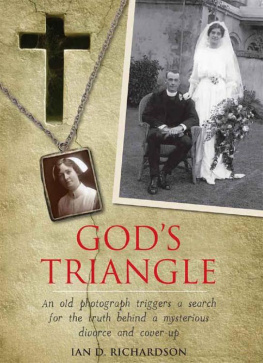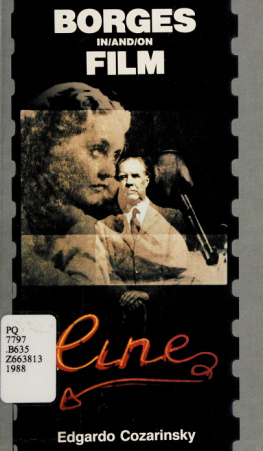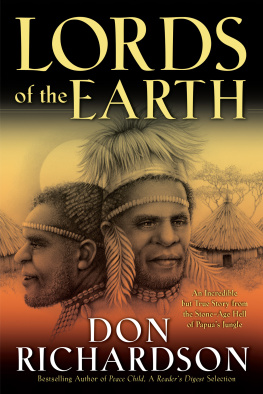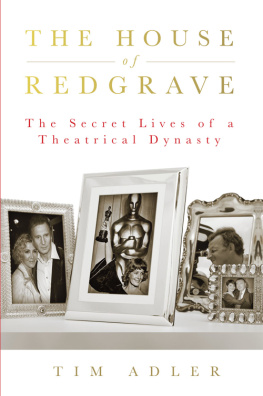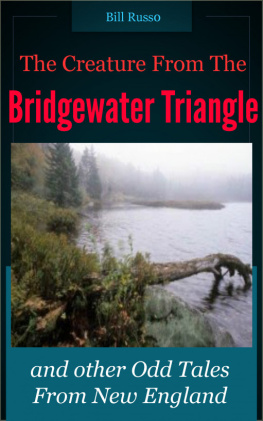
In memory of Florrie
GODS TRIANGLE
Ian D. Richardson
Second updated edition. Published in March 2013
by PREDDON LEE LIMITED 26 Ascott Avenue, London W5 5QB, United Kingdom
http:// www.preddonlee.com/ http:// www.godstriangle.com/
Ian D. Richardson, 2011
Cover design: Sally Wright, Hobart, Tasmania: http:// www.studiosalad.com.au/
Content editor and layout: Rosemary Batson
Ebook conversions: Lin White: http://www.coinlea.co.uk/
All rights reserved. No part of this publication may be reproduced or transmitted in any form or by any means, electronic or mechanical, nor may it be stored in any information storage and retrieval system, without prior permission from the publisher. The right of Ian D. Richardson to be identified as author of this work has been asserted in accordance with the Copyright, Designs and Patents Act 1988
ISBN 978-0-9571401-5-8
ABOUT THE AUTHOR
Ian Richardson was born in the Australian town of Wonthaggi, Victoria, but grew up in Charlton, North-Central Victoria, where his parents bought a printing and newspaper publishing business. He joined the family business on leaving school at the age of 16, not long before his father, John, died at an early age from cancer. After his widowed mother re-married and sold the business, he switched to broadcast journalism, first with Radio 3BO in Bendigo (where he met his wife Rosemary) then with Radio Melbourne 3AW.
Late in 1968, Ian and Rosemary set out for London, for what was initially intended to be a relatively short visit. But Ian was offered a job in the news department of BBC World Service and spent more than 25 years with the corporation. In the latter years, he moved into editorial management and project work, spending periods in charge of BBC World Service reporters and correspondents, as a senior editor of BBC World News television, and as the founding editor of BBC Arabic Television.
Both Ian and Rosemary have a keen interest in their respective family histories in the United Kingdom and Australia, and it was this interest that took them to the story of Gods Triangle.
THANKS
Firstly to my wife, Rosemary, for her considerable support and detective work over the years with Gods Triangle. This is not a lazy, courtesy appreciation, as she did a great deal of the early research. Further, she edited the content and advised on the layout.
My initial intention was that Gods Triangle be turned into a feature film, but Rosemary always felt that the story also needed to be written down in detail for the historical record. She was right. This book is the result.
I am also immensely grateful for the help given by Rosalind Gooden, a former Director of Personnel for the Australian Baptist Missionary Society, now known as Global interAction. Although we have often approached this story from different perspectives, I have been hugely impressed by her determination to support the historical truth, even if some people might prefer it to stay hidden.
Tribute must also be paid to the women who have found themselves in the same rare circumstances as my great aunt. A number of them kindly contacted me in response to a request for advice on what my great aunts life must have been like. These women wish to remain anonymous because even today they do not feel that society will fully sympathise or understand their lives.
Thanks must go also to the late Paul Paice, the only child of Frank Paice and his second wife, Olga. The story that I am about to tell was as much a surprise to him as it was to the rest of us, but he generously helped my research as much as he was able and always treated me with the greatest courtesy and friendship as the sometimes-uncomfortable story unfolded. Sadly, Paul died in August 2011 after a long battle with cancer.
Finally, I must mention the Australian film producer, Roslyn Walker of Walker Films, who has unstintingly supported Gods Triangle right from the time I first approached her in 1998, when she was in charge of script development for Film Victoria. Without her support, I might well have given up. Roslyn has now been joined by Julie Marlow of Deep Rock Films in developing a cinema version of Gods Triangle.
CONTENTS
Front cover illustrations:
Back cover illustrations:
Book illustrations:
INTRODUCTION
This is the true story of Florence Martha Cox.
Florrie, as she was widely known, was my great aunt. She died in Melbourne, Australia, in 1950, understanding little of the circumstances that destroyed her marriage and her life as a Baptist missionary in East Bengal (now Bangladesh). It is also an account of an establishment cover-up of the events surrounding her failed marriage, and of how her husband, the Rev. Frank E. Paice, and his second wife, Olga Johnston, erased a whole chunk of their past.
The story reveals much about the social constraints of an age when strict Christian virtues and rigid social taboos reigned supreme over intelligent open discussion and a realisation that lifes problems must not be viewed simply as black or white, or Christian good versus evil.
Gods Triangle is about my search for the truth surrounding my great aunt. The story would have remained a secret, had it not been for my mother casually showing me a photograph that excited my incurable journalistic curiosity.
I was brought up in a staunchly-Protestant environment, but I am no longer a believer, nor have I been since my late teenage years. Hence, this story is viewed through the prism of an atheist, but I hope believers will accept that I have done my best to tell the story with honesty and fairness.
My great aunt and her fellow Christian missionaries in India were mostly kind souls who genuinely believed that they had a God-given mission to link doing good with spreading the word of the Lord and obtaining conversions, heedless of the cost to themselves or the converts.
To Florries credit, there is evidence that her emphasis was more on doing good than on saving souls, although she was a passionate believer and would have applauded a world that was entirely Christian. Many modern missionaries now accept that proselytising in non-Christian countries is offensive and, sometimes, against local law. They, therefore, prefer to be Christians by example rather than campaigning evangelists.
As part of the cover-up some years later, most of the related official documents were lost or destroyed by the Baptist Church. All that remains in the church records are a few cryptic minutes from board meetings of the Baptist Foreign Mission Board in 1918 and 1919.
The families involved in events that I will recount also destroyed their records, or at least hid them where they hoped they wouldnt be found. Had it not been for old copies of the missionary magazines, The Southern Baptist, Our Indian Field and Our Bond, held in Baptist archives in Melbourne and in Oxford, England, it would have been impossible to get to the truth. The magazines themselves did not refer to any scandal, of course, but they did provide vital dates and other clues that helped my wife and me assemble a jigsaw.
A jigsaw is a perfect analogy for how our research progressed. Not all the pieces could be found, but we were able over the years to put together a reasonably complete picture. Sometimes, we would go weeks or months without finding a piece of the jigsaw and even when one was located, it wasnt always possible to know where it fitted. However, since the first edition was published a year ago, further information has emerged, requiring an additional chapter in this edition.

